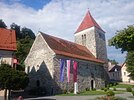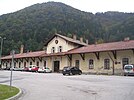Dravograd
This article needs additional citations for verification. (February 2013) |
Dravograd | |
|---|---|
From top, left to right: Overview of Dravograd, St. Vitus' Church, Post Office, St. John's Church from Dravograd castle, Railway Station, Town center | |
|
Carinthia | |
| Statistical region | Carinthia |
| Municipality | Dravograd |
| Area | |
| • Total | 2.40 km2 (0.93 sq mi) |
| Elevation | 390.4 m (1,280.8 ft) |
| Population (2020) | |
| • Total | 3,088 |
| • Density | 1,300/km2 (3,300/sq mi) |
| Vehicle registration | SG |
| [1] | |
Dravograd (pronounced
History
From 976 onwards the Dravograd area was part of the Duchy of Carinthia. The German name Unterdrauburg denoted the place where the Drava River left Carinthia and flowed into the neighbouring Duchy of Styria. It corresponded with Oberdrauburg up the river at Carinthia's western border with the County of Tyrol. The name Dravograd was invented during the Slovene national revival in the 19th century. Previously, the local Slovene name of the town was Traberk, a derivative of the German name Drauburg. The 19th century was a period of national awakening of the Carinthian Slovenes, and also of the rise of competing nationalisms: Slovene and German.
After the dissolution of the
In the
In April 1941, after the
In the
Sights
Ruins of the old Dravograd castle (also referred to as Castrum Trahburck) overlook the town from the hill above the area of old
The parish church in the settlement is dedicated to Saint John the Evangelist and belongs to the Roman Catholic Archdiocese of Maribor. It was first mentioned in written documents dating to the late 14th century. It was rebuilt in 1520 and in 1621. The current church is Baroque with a characteristic onion dome on its belfry.[2][7] A second church in the town is dedicated to Saint Vitus and is a late 12th-century Romanesque building.[8]
Lake Dravograd (Slovene: Dravograjsko jezero, Črneško jezero)[9]: 75–76 [10] is a reservoir upstream from the hydroelectric power plant, between Dravograd and Črneče. It is an important natural habitat included in Natura 2000.[9][10][11]
Transportation
The Dravograd railway station is on the Drautalbahn railway line from Maribor to Innichen (San Candido) in Italy, opened in 1863. Highway No. 3 leading from Maribor to the Austrian border runs through the town, where highway No. 10-10 to Celje branches off.
Dravograd Hydroelectric Power Plant

The power plant on the Drava River was built by the Germans during the Second World War, between 1941 and 1944.[12]: 128–132 It started operating in 1944 with two vertical Kaplan turbines. It was the first pier-type power plant in Europe (along with a similar plant in Lavamünd, built in the same period). In April 1945, the plant was bombed and damaged by Allied air strikes. Renovation started after the war, with the first turbine becoming operational in December 1945 and the second in January the next year. Renovation ended in 1955, when the third turbine was added.[12]
Refurbishment commenced in 1994, increasing the net capacity to 26.2 MW. Today the power plant can generate 142 million kWh of electricity annually, with an 8.9 m available head. Four 24 m wide spillways have a total spilling capacity of up to 5400 m3/s of water. For comparison, the highest water flows since construction of the power plant, measured during the 2012 floods, were 2570 m3/s. Three turbine piers are placed among the spillways. The plant reservoir is 10.2 km long and stretches up to the higher power plant at Lavamünd, Austria. It contains 5.6 million m3 of water.[13]
The power plant is one of eight power plants on the Drava River in Slovenia and is managed by the company Dravske Elektrarne Maribor.
Other data
- Postal code: SI-2370
- Area code: 02 (Maribor)
- Vehicle registration plate prefix: SG (Slovenj Gradec)
Notable people
Notable people that were born or lived in Dravograd include:
- Eva Boto, singer, represented Slovenia in the 2012 Eurovision Song Contest
- Boštjan Nachbar, basketball player
- Andrej Pečnik, football player
- Nejc Pečnik, football player
- Marijan Pušnik, football coach
- brothers Ivo Polančič and Lovro Polančič, anti-Nazi resistance fighters
- Anton Vogrinec, theologian
References
- ^ Statistical Office of the Republic of Slovenia
- ^ a b
Mirko Pak (1988). "Dravograd". COBISS 17411.
- ISBN 978-1-86011-336-9.
- ^ Dravograd municipal site
- ^ Janja Naglič (2008). "Vojna na Koroškem leta 1991" (PDF). Univerza v Ljubljani. Archived from the original (PDF) on 2017-09-13. Retrieved 2017-07-19.
- ^ Mira Časar, Tomo Jeseničnik (2016). Gradovi Mislinjske doline (PDF). Center za izobraževanje odraslih Slovenj Gradec. Archived from the original (PDF) on 2017-07-03. Retrieved 2017-07-03.
- ^ Slovenian Ministry of Culture register of national heritage reference number 2956
- ^ Slovenian Ministry of Culture register of national heritage reference number 126
- ^ Univerza v Ljubljani. pp. 75–76, 91–96. Archived from the original(PDF) on 2017-07-19. Retrieved 2017-07-19.
- ^ a b Walter Poltnig; Uroš Herlec. "Geološko-naravovarstvene strokovn podlage geoparka Karavanke" [Geological-Environmental Expert Bases of the Karawanks Geological Park] (PDF). p. 17. Archived from the original (PDF) on 2017-07-20. Retrieved 2017-07-19.
- ^ "Dravograjsko jezero". Osrednja in območne enote. Zavod Republike Slovenije za varstvo narave. Archived from the original on 2017-07-19. Retrieved 2017-07-19.
- ^ a b Gregor Novak (2016). Zgodovina dravskih hidroelektrarn med Dravogradom in Mariborom (Thesis). Univerza v Mariboru, Pedagoška fakulteta. Archived from the original on 2017-08-07. Retrieved 2017-08-07.
- ^ "Dravograd HPP". Power Plants. Dravske elektrarne Maribor. Archived from the original on 2017-08-07. Retrieved 2017-08-07.
External links
 Media related to Dravograd at Wikimedia Commons
Media related to Dravograd at Wikimedia Commons- Dravograd on Geopedia
- Dravograd Tourist Board
- Dravograd hydroelectric power station Archived 2012-02-07 at the Wayback Machine
- UL-Aero klub Aviofun Koroška







